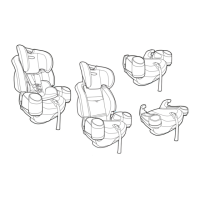56
4-A Booster Use
Highback Booster Use, With or Without
Armrests: 18-45 kg (40-100 lb) 110-
145 cm (43”-57”) at least 4 years old*
Booster Use Without Back: 18-45 kg
(40-100 lb) 110-145 cm (43”-57”) at
least 4 years old*
Booster Use Without Back Without
Armrests: 18-54 kg (40-120 lb) 110-
145 cm (43”-57”) at least 4 years old*
• Place booster seat forward-facing in the vehicle
back seat.
• Make sure vehicle seat’s lap belt is adjusted snugly
and lays low on the child’s hip and is routed behind
the armrest in the booster’s belt path.
• Vehicle belts MUST lie flat against child and MUST
NOT be twisted.
• Vehicle seat’s shoulder belt is adjusted snugly
and should lie between child’s neck and edge of
shoulder.
• Booster seat MUST be in the most upright position.
Vehicle Lap/Shoulder
Seat Belt
• Never use a vehicle lap-only belt across front of
child.
• DO NOT position vehicle shoulder belt under the
child’s arm or back.
• DO NOT allow child to slouch or slide down in the
booster seat.
• DO NOT position vehicle belt over top of armrests.
• Vehicle’s seat headrest SHOULD NOT create a
gap between vehicle seat and booster seat.
• The front of booster seat MUST NOT hang over
front of vehicle seat.
• If child will not keep vehicle belt properly
positioned, DO NOT use this booster seat. Use a
car seat with a 5-point harness system.
* Experts recommend that children should use a
built-in harness system car seat for as long as
possible until they reach the maximum forward-
facing weight or height for their car seat. After
reaching the maximum forward-facing weight or
height, they also recommend that children 145
cm (4 feet 9 inches) tall or under should ride in
a belt-positioning booster seat. This car seat can
remain forward-facing using the built-in harness
system for children up to 30 kg (65 lb) or 125 cm
(49”).

